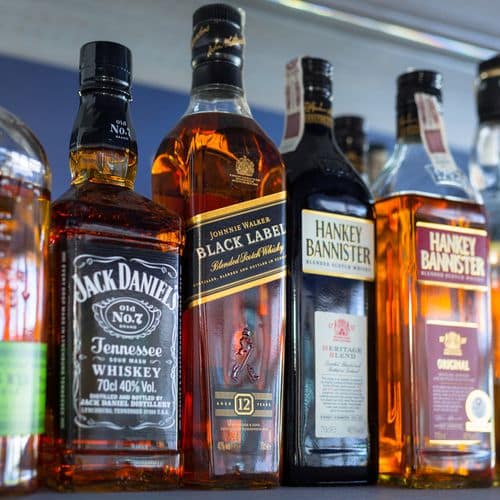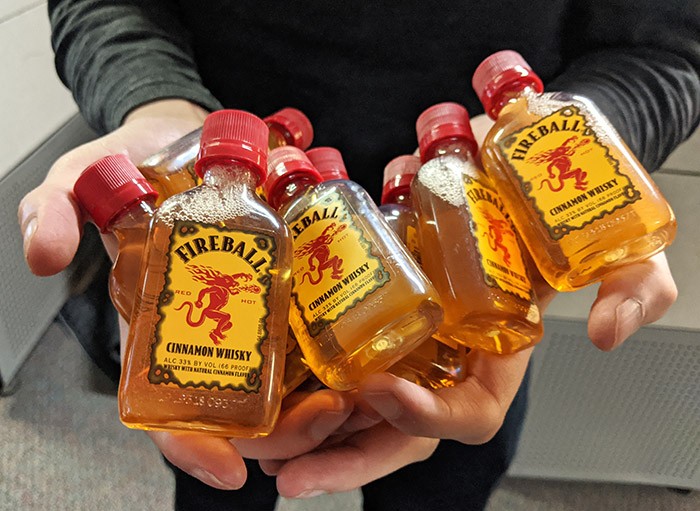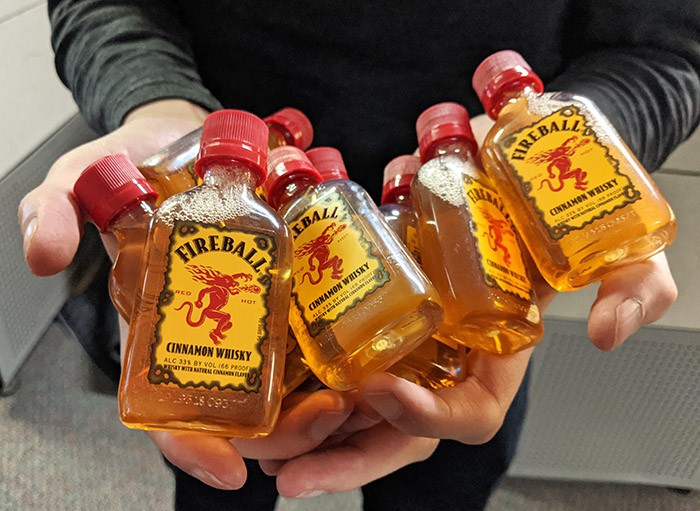Ah, the age-old question that beckons both the curious and the adventurers among us. We find ourselves pondering the intoxicating powers of that golden elixir known as whiskey. As we embark on a quest to unearth the truth, we venture into the world of spirits, exploring the effects that this beloved beverage can have on our senses, our inhibitions, and perhaps even our destinies. Join us as we navigate the realm of whiskey’s potency, and discover whether its charms can truly transport us into a state of pleasant inebriation.

This image is property of www.theglobeandmail.com.
What is Whiskey?
Whiskey is a popular alcoholic beverage that has been enjoyed by people around the world for centuries. It is a distilled spirit that is typically made from fermented grain mash, which can include barley, corn, rye, and wheat. The exact ingredients and production methods can vary depending on the region and type of whiskey being produced, but the basic process involves mashing the grains, fermenting the mash, distilling the liquid, and aging it in wooden barrels.
Definition of Whiskey
Whiskey is defined as a type of distilled alcoholic beverage made from fermented grain mash. It is typically aged in wooden barrels, which gives it its distinct flavor and character. The term “whiskey” is derived from the Irish word “uisce beatha” and the Scottish Gaelic word “uisge beatha,” both of which mean “water of life.” The production and labeling of whiskey are regulated by various laws and regulations depending on the country of origin.
Ingredients of Whiskey
The ingredients used to make whiskey can vary depending on the type of whiskey being produced, but the main component is usually grains. Common grains used in whiskey production include barley, corn, rye, and wheat. The grains are typically milled and mixed with water to create a mash, which is then fermented using yeast. The fermentation process converts the sugars in the grains into alcohol, creating a liquid known as the “wash.” This wash is then distilled to increase the alcohol content and remove impurities, resulting in the production of whiskey.
Different Types of Whiskey
There are various types of whiskey, each with its own distinct characteristics and production methods. Some of the most well-known types include Scotch whisky, Irish whiskey, bourbon, and rye whiskey. Scotch whisky is typically made from malted barley and aged for a minimum of three years in oak barrels. Irish whiskey, on the other hand, can be made from a mixture of grains and is usually triple-distilled. Bourbon is a type of American whiskey that is primarily made from corn and aged in charred oak barrels, while rye whiskey is made primarily from rye grain and has a spicier flavor profile.
Alcohol Content in Whiskey
Understanding ABV (Alcohol by Volume)
The alcohol content in whiskey is measured using the term ABV, which stands for Alcohol by Volume. ABV is expressed as a percentage and represents the amount of pure alcohol present in a given volume of the beverage. For example, if a whiskey has an ABV of 40%, it means that 40% of the volume of the drink is made up of pure alcohol.
Average Alcohol Content in Whiskey
The average alcohol content in whiskey can vary depending on the type of whiskey and the brand. Most whiskeys have an ABV ranging from 40% to 50%. However, there are also higher-proof whiskeys available on the market that have ABVs above 50%. It’s important to note that the alcohol content can significantly impact the taste and intensity of the whiskey.
Higher vs. Lower Alcohol Content Whiskey
Whiskeys with a higher alcohol content can provide a stronger and more intense flavor profile. These whiskeys often have a higher proof and may be enjoyed by individuals who prefer a more robust and bold taste. On the other hand, whiskeys with a lower alcohol content can have a smoother and more mellow flavor. These whiskeys may be more approachable for individuals who are newer to whiskey or prefer a gentler drinking experience.
Effects of Whiskey on the Body
How Alcohol is Absorbed into the Body
When whiskey is consumed, the alcohol is rapidly absorbed into the bloodstream through the walls of the stomach and the small intestine. From there, it is transported to various organs and tissues throughout the body, including the brain. The speed at which alcohol is absorbed can be influenced by several factors, such as the concentration of alcohol in the drink, the presence of food in the stomach, and individual variations in metabolism.
Metabolism of Alcohol in the Body
Once alcohol is in the bloodstream, it is primarily metabolized by the liver. The liver breaks down alcohol into acetaldehyde, a toxic substance, and then further metabolizes it into acetate, which is eventually eliminated from the body as carbon dioxide and water. The rate at which alcohol is metabolized can vary depending on factors such as age, sex, body weight, and overall health.
Short-Term Effects of Alcohol Consumption
When whiskey is consumed, it can produce various short-term effects on the body. These effects can include feelings of relaxation, reduced inhibitions, and a temporary increase in confidence. However, excessive consumption of whiskey or any alcoholic beverage can lead to negative effects such as impaired judgment, dizziness, nausea, and coordination difficulties. It’s important to consume alcohol responsibly and be aware of the potential risks and consequences associated with excessive drinking.
Factors Affecting Intoxication
Amount of Whiskey Consumed
One of the primary factors that affects intoxication is the amount of whiskey consumed. The more whiskey a person drinks, the higher the concentration of alcohol in their bloodstream, and the more pronounced the effects of intoxication will be. It’s essential to drink in moderation and be aware of the recommended guidelines for safe alcohol consumption.
Drinking Speed
The speed at which whiskey is consumed can also impact the level of intoxication. Drinking whiskey quickly can lead to a rapid increase in blood alcohol concentration, which can impair judgment and coordination more quickly than if the same amount of whiskey is consumed over a more extended period. It’s important to pace oneself and drink responsibly to avoid the negative consequences of drinking too quickly.
Body Weight and Metabolism
Individual factors such as body weight and metabolism can influence how alcohol is processed and eliminated from the body. Generally, individuals with a higher body weight and a slower metabolism may have a higher tolerance for alcohol and may be able to consume more whiskey without experiencing the same level of intoxication as someone with a lower body weight and faster metabolism. However, it’s important to note that even individuals with a higher tolerance can still be at risk of negative effects from excessive whiskey consumption.
Tolerance to Alcohol
Tolerance to alcohol can develop over time with regular and consistent alcohol consumption. Regular whiskey drinkers may find that they need to consume more whiskey to achieve the same level of intoxication as when they first started drinking. While tolerance can make it easier to consume larger amounts of alcohol, it does not eliminate the potential risks and negative consequences associated with excessive drinking.
Mixing Whiskey with Other Substances
Mixing whiskey with other substances, such as energy drinks or prescription medications, can have unpredictable and potentially dangerous effects. Some substances can interact with whiskey and increase the risk of adverse reactions, including increased heart rate, drowsiness, and impaired judgment. It’s important to avoid mixing whiskey with other substances unless under the guidance of a healthcare professional.
This image is property of i0.wp.com.
Blood Alcohol Concentration (BAC)
Understanding BAC
Blood Alcohol Concentration (BAC) is a measurement used to assess the level of alcohol in a person’s bloodstream. It is expressed as a percentage and represents the grams of alcohol per deciliter of blood. BAC is an objective way to determine a person’s level of intoxication and is often used by law enforcement officers to assess whether someone is legally impaired.
Calculating BAC
BAC can be influenced by several factors, including the amount of alcohol consumed, the rate of consumption, body weight and metabolism, and the presence of food in the stomach. Various calculators and formulas can help estimate BAC based on these factors, but it’s important to note that individual responses to alcohol can vary, and the calculated BAC may not always reflect actual impairment.
Impaired Judgement and Visibility
As BAC increases, the effects of alcohol on the body become more pronounced. Impaired judgment is one of the first noticeable effects of alcohol consumption, leading to risky behaviors and poor decision-making. Additionally, alcohol can impair visibility by affecting eye movement control, making it more challenging to focus, track moving objects, and respond quickly to changes in the environment. Driving or operating machinery under the influence of whiskey or any alcoholic beverage is extremely dangerous and illegal in most jurisdictions.
Level of Intoxication
Different Levels of Intoxication
Intoxication can range from mild to severe, depending on the individual’s BAC and tolerance to alcohol. Mild intoxication may result in feelings of relaxation and reduced inhibitions, while moderate intoxication can lead to impaired coordination and judgment. Severe intoxication can cause significant impairment, including confusion, loss of consciousness, and potential alcohol poisoning.
Signs of Drunkenness
Signs of drunkenness can vary depending on the individual and the level of intoxication. Some common signs of drunkenness include slurred speech, impaired coordination, difficulty walking or standing, impaired judgment, slowed reaction times, and altered mood or behavior. It’s important to recognize these signs both in oneself and others to ensure the safety and well-being of everyone involved.
This image is property of tinroofdrinkcommunity.com.
Risks and Consequences of Excessive Whiskey Consumption
Short-Term Risks
Excessive whiskey consumption can lead to a range of short-term risks and consequences. These can include alcohol poisoning, blackouts, injuries from falls or accidents, impaired decision-making leading to risky behaviors, and conflicts or altercations with others. It’s important to drink responsibly and be aware of one’s limits to avoid these potential risks.
Long-Term Health Risks
Long-term excessive whiskey consumption can have severe health consequences. Chronic heavy drinking can lead to liver damage, including liver inflammation (hepatitis), liver cirrhosis, and an increased risk of liver cancer. It can also contribute to the development of other health conditions such as cardiovascular diseases, pancreatitis, and certain types of cancer. Prolonged whiskey consumption can also increase the risk of addiction and alcohol dependence.
Legal Consequences
Excessive whiskey consumption can lead to legal consequences, particularly if it involves impaired judgment and risky behaviors such as driving under the influence. Driving while intoxicated is a serious offense that can result in fines, license suspension or revocation, and even imprisonment, depending on the jurisdiction and the severity of the offense. It’s essential to prioritize safety and never drink and drive.
Responsible Drinking Guidelines
Standard Drink Measurements
Understanding standard drink measurements can help individuals track their alcohol consumption and drink responsibly. In the United States, a standard drink is defined as 14 grams (0.6 ounces) of pure alcohol, which is typically equivalent to one 1.5-ounce shot of whiskey. However, it’s important to note that different countries may have varying definitions of a standard drink, so it’s essential to be familiar with the specific guidelines and recommendations of one’s own region.
National Drinking Guidelines
National drinking guidelines can provide valuable information on recommended limits for alcohol consumption. These guidelines often take into account factors such as age, sex, and overall health. It’s important to familiarize oneself with these guidelines and strive to drink within the recommended limits to reduce the risk of negative health effects and alcohol-related consequences.
Moderation and Safety Precautions
Drinking whiskey or any alcoholic beverage should always be done in moderation and with safety precautions in mind. It’s recommended to pace oneself, alternate alcoholic drinks with non-alcoholic beverages, and avoid excessive or binge drinking. It’s also essential to be aware of one’s personal limits and the potential risks associated with alcohol consumption. If necessary, enlist the support of a designated driver or make alternative transportation arrangements to ensure a safe journey home.
This image is property of i0.wp.com.
Identifying Alcohol Abuse
Recognizing Signs of Alcohol Abuse
Alcohol abuse refers to a pattern of excessive drinking that can lead to negative consequences. It’s important to be able to recognize the signs of alcohol abuse in oneself or others. These signs can include an inability to limit or control alcohol consumption, neglecting responsibilities due to drinking, experiencing withdrawal symptoms when not drinking, and continuing to drink despite negative physical, mental, or social effects.
Getting Help and Support
If alcohol abuse or alcohol addiction is identified, it’s important to seek help and support. There are various resources available, including support groups, counseling, and treatment programs, that can assist individuals in overcoming alcohol-related challenges. Seeking professional help can provide the necessary guidance and support to make positive changes and improve overall well-being.
FAQs about Whiskey and Intoxication
Can Whiskey Get You More Drunk Than Other Alcoholic Beverages?
Whiskey, like other alcoholic beverages, contains ethanol, which is the active ingredient responsible for intoxication. The alcohol content in a drink determines its potential to cause intoxication. If the whiskey and another alcoholic beverage have the same alcohol content, they will have an equal potential to get someone drunk. It’s essential to consider the alcohol content of the specific drink rather than the type of alcohol itself.
Does Whiskey Make You Aggressive?
Alcohol, including whiskey, can affect mood and behavior. Some individuals may experience increased aggression or irritability when under the influence of alcohol. However, it’s important to note that the effects can vary significantly between individuals. Alcohol can influence mood and behavior based on individual factors, environment, and the amount consumed. It’s essential to consume alcohol responsibly and be aware of any changes in mood or behavior.
Is It Safe to Drink Whiskey Daily?
Regular daily consumption of whiskey or any alcoholic beverage can lead to health risks, including liver damage, addiction, and other alcohol-related health conditions. It’s generally recommended to consume alcohol in moderation and to have alcohol-free days to prevent the development of a dependence on alcohol. If there are concerns about alcohol consumption or potential health risks, it’s advisable to consult with a healthcare professional.
Can You Drive After Drinking Whiskey?
Driving under the influence of whiskey or any alcoholic beverage is illegal and extremely dangerous. Alcohol impairs judgment, coordination, reaction time, and visibility, all of which are crucial for safe driving. It’s essential to designate a sober driver or use alternative transportation methods if alcohol has been consumed. It’s always better to prioritize safety and prevent the potential harm caused by driving while intoxicated.
Can Mixing Different Whiskeys Increase Intoxication?
Mixing different types of whiskeys does not increase intoxication. The alcohol content of the individual whiskeys determines the level of intoxication. Mixing different whiskeys may impact the taste and flavor profile of the drink, but it does not result in a higher alcohol content. It’s important to keep track of the overall alcohol content consumed and drink responsibly to mitigate the risks associated with excessive drinking.
In conclusion, whiskey is a beloved alcoholic beverage with various types and flavors. Understanding the alcohol content, effects on the body, and risks of excessive consumption is crucial for responsible drinking. By following guidelines, recognizing the signs of alcohol abuse, and seeking help if needed, individuals can make informed choices and ensure their well-being while enjoying the pleasures of whiskey in moderation.
This image is property of lovingwhiskey.com.




